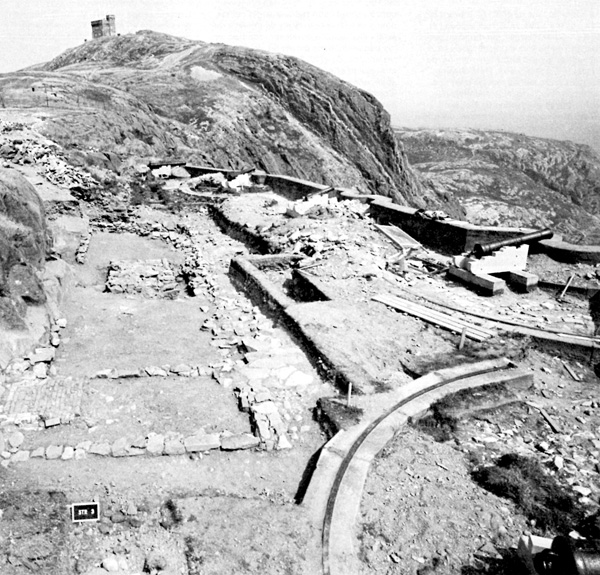|
|
 |
Canadian Historic Sites: Occasional Papers in Archaeology and History No. 1
Archaeological Investigations of the National Historic Sites Service, 1962-1966
by John H. Rick
Excavations in Newfoundland
Signal Hill
During the summer of 1965, Edward B. Jelks, assisted
by J. Ned Woodall and Carole D. Yawney, directed a three-month
excavation program at Signal Hill National Historic Park in St. John's.
The following summer, Jelks carried out an additional two months of
work, this time with the assistance of Woodall and Stephen B.
Archibald.
Signal Hill, a typical rugged Newfoundland headland,
dominates the narrow entrance to the harbour of St. John's. This large
harbour became one of the focal points of the important Grand Banks
fishery early in the 16th century and played an important part in the
lengthy struggle between France and Britain for control of North
America. The early fortifications were located near sea level, Signal
Hill itself not being fortified until the 1790s; consequently, most of
the remains on the hill date from the 19th century.
Test excavations were carried out on the site of the
proposed visitors' centre to ensure that no archaeological remains would
be destroyed by the planned construction, but little of importance was
uncovered in this area. Most of the 1965 work was centered on the
Queen's Battery, a gun emplacement overlooking the entrance to the
harbour; here barracks and magazines were among the structures excavated
(Jelks 1965). The second season's excavations (Jelks 1967) included a
commissariat building, blockhouse and canteen, all located on Ladies
Lookout, the highest point on Signal Hill. These structures date chiefly
from the first third of the 19th century, as does the extensive
collection of military and civilian artifacts recovered.

3 The Lower Queen's Battery of Signal Hill,
Newfoundland, after excavation in 1965, looking ENE, toward Cabot Tower
in the background. The low scarp (left) was cut to accommodate the wall
of Structure 3, whose stone foundations are shown in the centre
foreground. Two of the forged iron racers mounted on cut stone curbs
(right) may be compared with those of the St. Andrews Blockhouse
(see Fig. 8).
(Edward B. Jelks.)
|
Castle Graves
In 1965, Roger T. Grange, Jr., assisted by Karalee A.
Coleman and Donald G. MacLeod, excavated Castle Graves, a small stone
fort on Castle Hill overlooking the town of Placentia. Construction
started in 1694 when the French erected a small masonry redoubt on
Castle Hill to protect the low-lying harbour defenses; this redoubt was
subject to frequent and extensive changes over the next decade. In 1713,
Newfoundland was ceded to the British and the French abandoned the
Placentia forts, subsequently establishing their main base at
Louisbourg. The British tended to concentrate on the shore defenses
immediately around the town, and the fortifications on the hill slowly
fell into ruin. The hill was refortified in 1758, but there followed a
number of years of neglect interspersed with brief periods of repair and
reconstruction. By 1805, the site was virtually abandoned (Ingram
1964).
The 1965 investigations resulted in the complete
excavation of all the major buildings in the fort. All of the critical
exterior angles were exposed to a degree sufficient to project the line
of the masonry wall around the entire perimeter of the redoubt (Grange
1965). The chief areas still undug are the gun platform, the well and
the dry masonry wall around the edge of the site; these will be left for
investigation in conjunction with future site development work.
|

